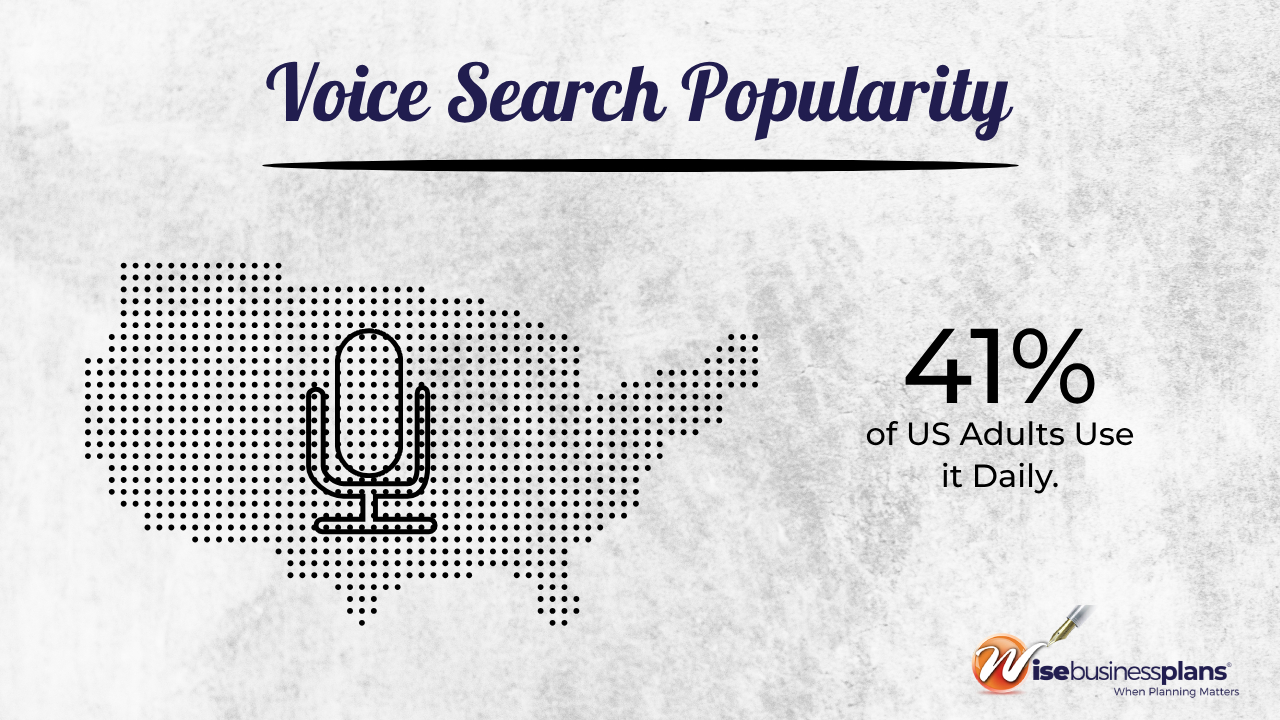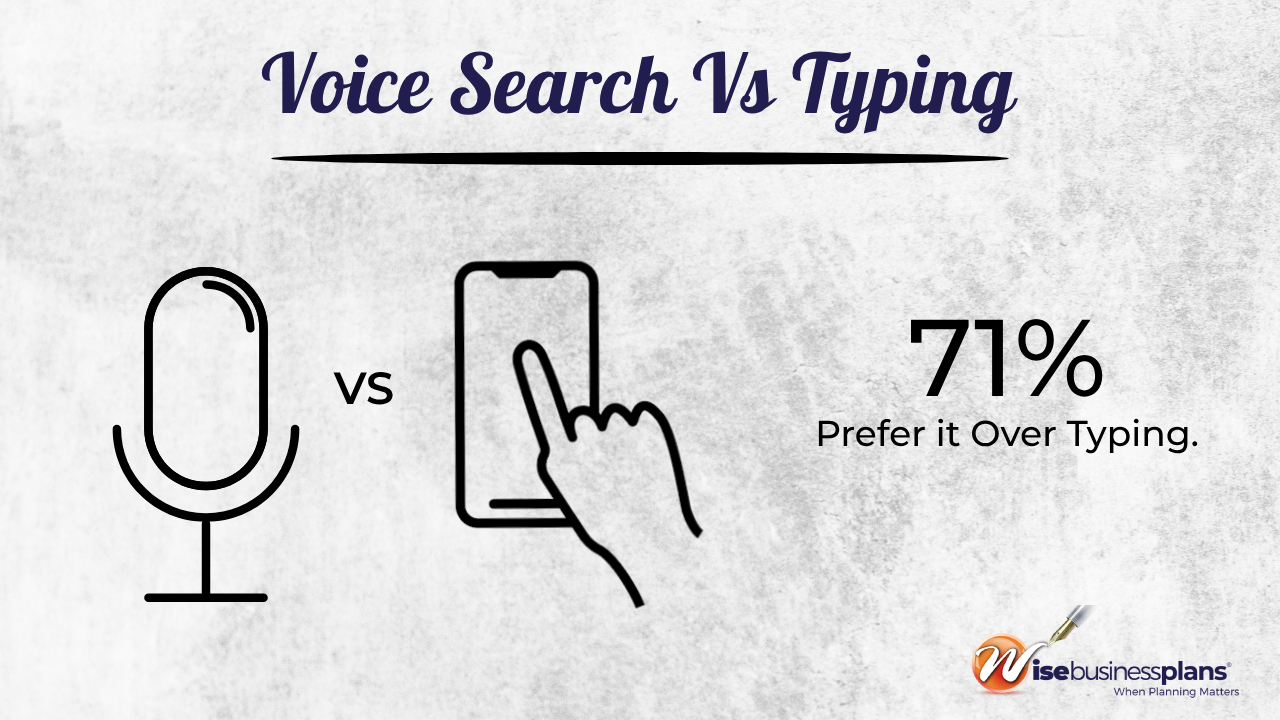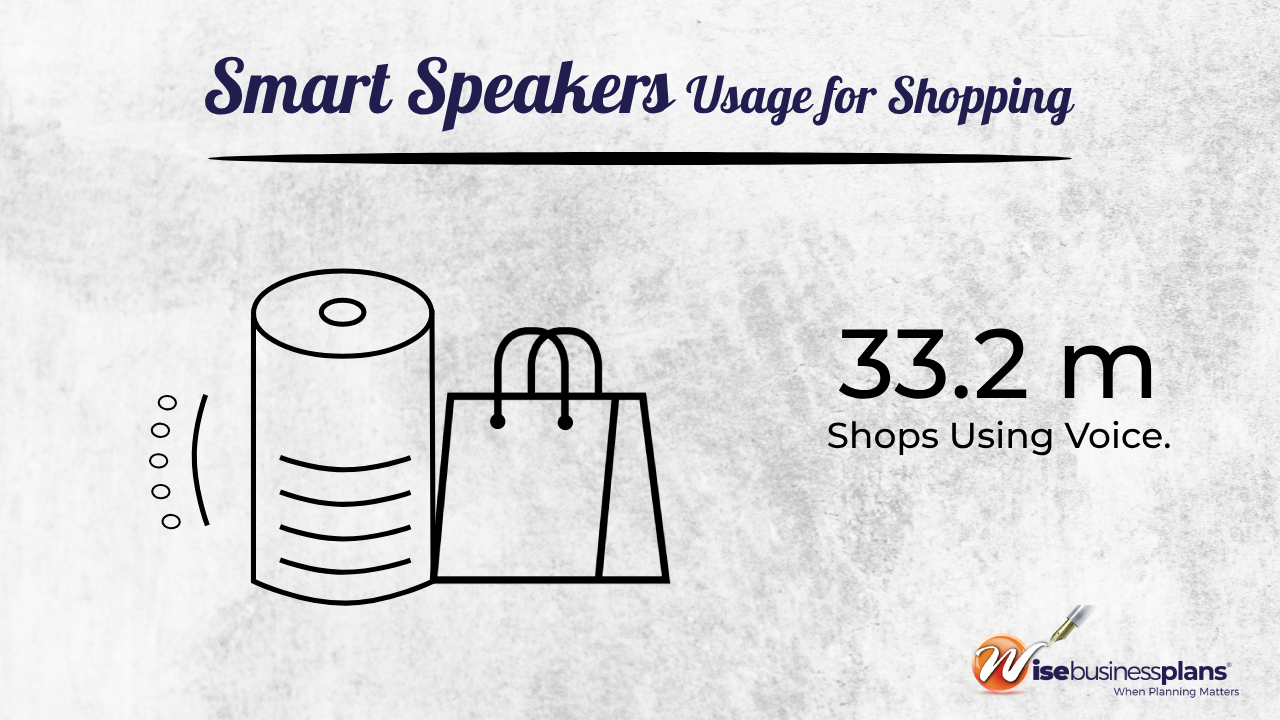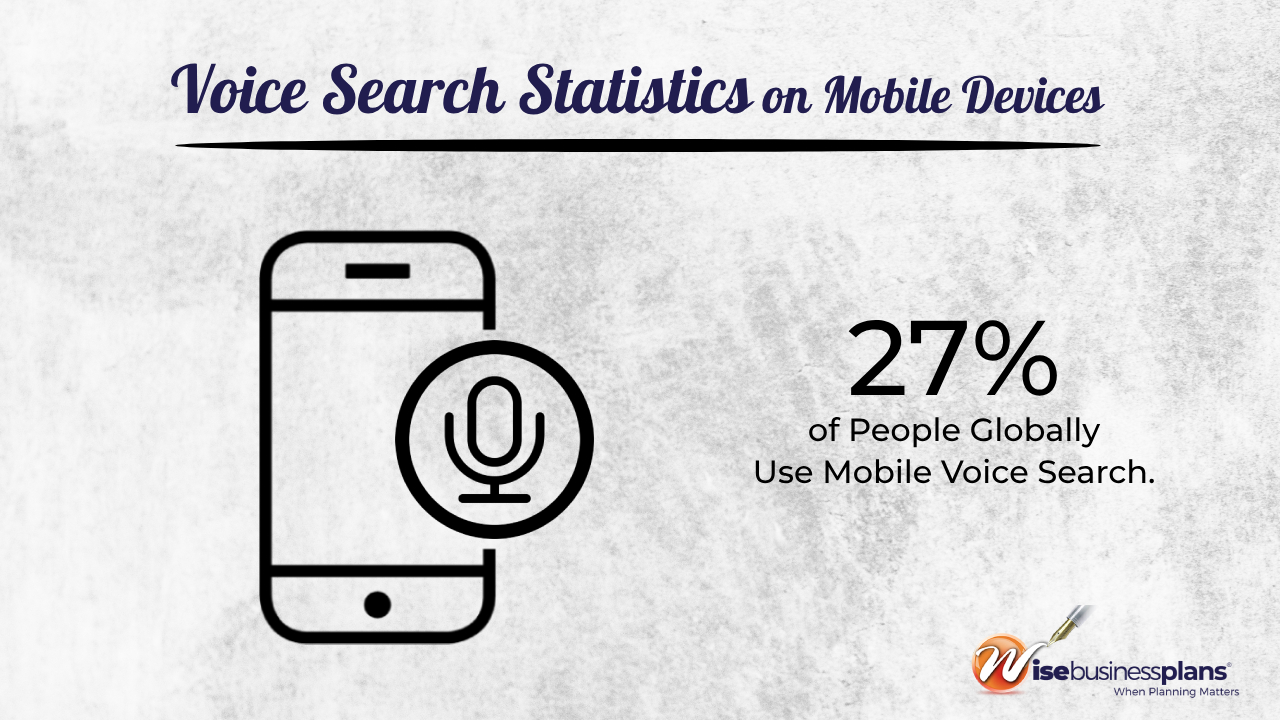Voice Search Statistics in the United States – 2024
Table of Contents
- What is Voice Search Statistics?
- 1. Voice Search Popularity
- 2. Smart Speakers Ownership in The US
- 3. Voice Search vs. Typing
- Simplify your business plan creation with our efficient service.
- 4. Smart Speakers Usage in The US
- 5. Smart Speakers Usage for Shopping
- 6. Role of Voice Search in Buyer’s Purchase Journey
- 7. Voice Ads Are More Engaging
- 8. Voice Search Statistics on Mobile Devices
- Want to Explore industry-specific Business Plan Examples or Samples?
- 9. Uses of Voice
- 10. Voice Search Engagement
- 11. Voice Search Optimization for Websites
- 12. Local Voice Search and Business Impact
- 13. Voice Search and E-Commerce Strategy
- 14. Voice Search Privacy and Security Concerns
- 15. Future Trends in Voice Search
- Conclusion
- Summary of "Voice Search Statistics in 2025"
What is Voice Search Statistics?
“Voice search statistics” refers to data and information related to the usage, trends, and patterns of voice-activated search queries conducted by users through voice-enabled devices and technologies. These statistics can include details such as the popularity of voice search, the devices and platforms people use for voice searches, the types of queries they make, and the impact of voice search on various industries, among other relevant insights.
1. Voice Search Popularity

An increasing number of people in the United States are using voice to conduct searches. Recent reports estimate that currently, half of the US population uses voice search features daily, and more than one-third (34%) use them at least once a week (UpCity, 2022).
The majority of voice search users have experienced users of its features, with nearly three out of every four (72 percent) of them having used it for between one to five years.
In fact, as many as 16 percent say they’ve been relying on voice search for more than half a decade. As we’ll explore in the next few voice search statistics, smartphones, and smart speakers are currently the most popular devices among voice search users.
But with other gadgets such as watches and wearables, TVs, and home appliances slowly offering voice search features, it may just be a matter of time before they become equally as popular – if not more.
2. Smart Speakers Ownership in The US
As of 2022, more than one in three (35 percent) US consumers possessed smart speakers (Statista, 2022). This marked a two percentage point annual increase and 11 percentage points over 2020, an indication of the growing popularity of these devices.
Recent data also shows that tech giants Amazon, Google, and Apple dominate the smart speaker market share in the US. With 94.2 million of its smart speakers in use, Amazon leads its competitors by a significant margin.
In comparison, 46.7 million people in the US own smart speakers by Google, which is fewer than half of Amazon. Statistics show, however, that the popularity of Google’s smart speakers has been rising quickly in recent years. Their sales grew a whopping 234 percent from 2019 to 2021.
That being said, we can probably expect to see the gap between Amazon and Google narrow in the near future.
3. Voice Search vs. Typing

Nearly gone are the days of typing in a search query. Approximately seven out of ten consumers (71 percent) prefer to use voice searches to conduct a query over the traditional method of typing (PricewaterhouseCoopers,2018).
Despite more advanced features voice search capabilities offer such as carrying out online purchases or controlling other smart home gadgets, its most popular usages remain restricted to more basic features. Conducting basic queries and information requests aside, users like to use voice searches to do basic tasks like checking on the weather, playing music, and setting reminders.
But given the potential and benefits of voice search, it’s no wonder that it’s growing in popularity. This is particularly noteworthy for the disabled community and the visually impaired, who have benefitted from voice search as it allows them to bypass the inconvenient text-based functions.
4. Smart Speakers Usage in The US
Ownership of smart speakers is on the rise, but so is voice search usage with smart speakers. 52 percent of all smart speaker owners use their devices daily (NPR, 2018). Over one-third use it to carry out voice searches.
Given the increasing use and popularity of smart speakers, if you happen to run an e-commerce business selling tech gadgets, consider amping up your marketing efforts around November.
The period between Black Friday and the end of the year is proving to be a particularly popular time for purchases of smart speakers – eight percent of the US population bought a smart speaker during this period in 2018.
Depending on your target market, you may want to prioritize one brand over another. Just so you have an idea, Amazon currently holds about 70 percent of the smart speaker market share within the US, far outperforming its main rivals, Google Home and Apple’s HomePod.
5. Smart Speakers Usage for Shopping

The rising ownership of smart speakers coupled with increasing e-commerce growth means more and more people have started to turn to their smart speakers to shop online. In fact, the latest research figures show that as many as 33.2 million consumers in the US were expected to shop using the voice search feature on their smart speakers in 2022 (eMarketer, 2020).
To put things in perspective, this would represent a 3.5 percent growth from 2021’s 32.1 million and 14.1 percent of the total number of digital shoppers in the US. If you’re thinking about targeting consumers using smart speakers to shop, it’s important to know what they’re buying via voice.
Most purchases made via voice are for health and beauty products. In the period from August 2019 to August 2021, analysts estimate that as many as 8.9 million health and beauty products were bought via smart speakers.
This is followed by the electronics category, which saw 8.8 million purchases.
Household supplies have also proven to be particularly popular items to be bought using smart speakers. Some 8.5 million household products were bought using voice during this period.
6. Role of Voice Search in Buyer’s Purchase Journey
With more and more people opting to shop via voice search, it’s important to understand at which stage of the purchase funnel their dependence on voice search is the highest.
Survey results show that online shoppers use voice assistants more extensively in the pre-checkout stages than for checking out – particularly in product research and addition to shopping lists.
More than half of all online shoppers in the US use voice assistants to help them research products, while over a third use them to add new items to their shopping lists (Narvar, 2018).
But it doesn’t end there. Voice assistants continue to feature in the post-checkout stages, with 30 percent of online shoppers using it to track their packages, 20 percent leaving reviews or ratings, and 17 percent using voice search to repurchase items.
Considering the above-mentioned voice search statistics on shopping, as an e-commerce owner, you may want to consider optimizing your site for voice search!
7. Voice Ads Are More Engaging
Just like all forms of media, ads also form a part of voice search. In fact, as many as one in four consumers say they have heard an ad on a smart speaker before. But there is one thing that differentiates voice ads heard on smart speakers from other more conventional forms of advertising such as print, TV, online, and social media – consumers tend to be more accepting of voice ads.
The latest voice search statistics show that 38 percent of consumers who have heard voice ads on smart speakers find them to be less “intrusive” (Adobe, 2019). 39 percent also say they are more engaging. According to experts, it’s because voice ads have the ability to resonate with consumers on a higher level emotionally and personally.
Not only do consumers relate better to voice ads, but they’re also responding better to them. Nearly 40 percent of people who heard a voice ad proceeded to purchase the item that was being advertised.
8. Voice Search Statistics on Mobile Devices

Currently, more than a quarter (27 percent) of the global online population is using the voice search feature on their mobile devices. (GlobalWebIndex, 2018) Usage is particularly popular among the 16-to-34 age bracket, with two-thirds of mobile voice search users falling into this particular age group.
If your e-commerce business targets both females and males, you’ll be happy to know that you may not need different strategies for these two gender groups as mobile voice search usage across both men and women is pretty even: 28 percent of men use voice-assisted searches on their mobile devices, compared to 26 percent of women.
In terms of markets, mobile voice search features are particularly popular among Asian countries.
This is especially so in Indonesia, China, and India, where 38 percent, 36 percent, and 34 percent of all internet users reportedly carry out voice-assisted searches on their mobile gadgets.
For comparison’s sake, just 25 percent of US internet users use the voice search feature on their mobile devices.
9. Uses of Voice
From the above voice search statistics, it’s clear that the technology is becoming increasingly popular and has the potential to revolutionize consumers’ daily lives. But what are people using voice technology for?
According to a recent survey conducted on the use of voice search, the top task given to voice assistants by users is to check the weather, with around one in six (17 percent) users doing so (UpCity, 2022).
This is followed by looking for nearby establishments such as restaurants and shops – carried out by 16 percent of voice search users. 14 percent also use voice assistants to conduct hands-free searches while driving, and 13 percent use them to look up definitions and facts.
Looking for online products and services is also a popular use of voice search – a statistic e-commerce businesses should definitely be aware of.
10. Voice Search Engagement

72 percent of US consumers are engaging with voice search through digital assistants such as Siri, Alexa, Google Assistant, and Cortana (Microsoft, 2018). Of them, Google Assistant and Apple’s Siri are the two most popular digital assistants, with 36 percent of all US consumers reported to have used them for voice searches.
This is followed by percent by Amazon’s Alexa and 19 percent by Microsoft’s Cortana. Of all the gadgets available that offer voice-assisted search functions, smartphones appear to be the leading device of choice for voice search users.
More than 90 percent of consumers report having used their smartphones to carry out voice searches, compared to less than half on their smart speakers and just over four in ten through in-car voice assistants.
11. Voice Search Optimization for Websites
With the growing popularity of voice search, website owners and businesses are increasingly focusing on optimizing their online presence for voice queries. To enhance your website’s visibility in voice search results, consider incorporating natural language keywords and phrases that people commonly use in their spoken queries.
Long-tail keywords and question-based phrases are particularly effective for voice search optimization.
Additionally, ensure that your website content provides concise and relevant answers to frequently asked questions related to your industry or niche. Structured data markup can also help search engines better understand and present your content in voice search results.
12. Local Voice Search and Business Impact
Local businesses can benefit significantly from the rise in voice search, as consumers often use voice queries to find nearby stores, restaurants, and services.
To leverage this trend, ensure that your business information, including location, contact details, and hours of operation, is accurate and up-to-date on online platforms like Google My Business.
Encourage satisfied customers to leave positive reviews, as these can boost your local search rankings. Creating content that addresses local topics and events can also help attract voice search users looking for information about their immediate surroundings.
13. Voice Search and E-Commerce Strategy
E-commerce businesses should consider voice search as a critical component of their digital marketing strategy. Voice shopping is on the rise, and consumers are increasingly using voice assistants to make purchases.
To tap into this market, ensure that your online store is voice-search-friendly by optimizing product descriptions with natural language, implementing voice-friendly navigation, and offering voice-exclusive promotions.
Creating a seamless voice shopping experience can help your e-commerce business stay competitive in the evolving digital landscape.
14. Voice Search Privacy and Security Concerns
As voice search becomes more integrated into our daily lives, concerns about privacy and security are also on the rise. Users may worry about the data collected by voice-enabled devices and its potential misuse. It’s essential for businesses and technology companies to prioritize data protection and transparency.
Clearly communicate your data usage policies to users and provide options for controlling and deleting voice data. Addressing privacy concerns can help build trust with your audience and encourage continued adoption of voice search technology.
15. Future Trends in Voice Search
The future of voice search holds exciting possibilities, with ongoing advancements in natural language processing and artificial intelligence. We can expect voice assistants to become even more integrated into our daily routines, offering personalized recommendations and assistance across various devices.
Voice search will likely extend beyond smartphones and smart speakers to smart cars, home appliances, and wearable devices. Staying updated on these emerging trends and technologies will be crucial for businesses looking to remain at the forefront of voice search optimization and provide enhanced user experiences in the years to come.
Conclusion
In 2025, voice search has gained significant popularity in the United States, with around half of the population using it daily and a considerable portion relying on it for several years. Consumers prefer voice searches over typing, finding them convenient for various tasks.
Smart speaker ownership has surged, with Amazon leading the market and Google’s speakers quickly gaining ground. Voice search has also become a prominent driver of online shopping, especially for health and beauty products.
It plays a vital role throughout the purchase journey, from product research to post-purchase activities. Businesses are actively optimizing for voice search, and local businesses can benefit by ensuring accurate information and encouraging positive reviews.
However, addressing privacy concerns remains a crucial aspect of building user trust in voice search technology.
Summary of "Voice Search Statistics in 2025"
- Voice Search Popularity: Approximately half of the US population uses voice search daily, with 34% using it at least once a week. A significant portion of users has been relying on voice search for several years, with 16% using it for more than half a decade.
- Voice Search vs. Typing: 71% of consumers prefer voice searches over traditional typing. While voice search offers advanced features, its most popular uses include checking the weather, playing music, and setting reminders.
- Smart Speakers Ownership in The US: In 2022, 35% of US consumers owned smart speakers, with Amazon leading the market. Google’s smart speakers are also gaining popularity.
- Smart Speakers Usage in The US: More than 50% of smart speaker owners use them daily, and many use them for voice searches. Smart speakers see a surge in sales around the holiday season.
- Smart Speakers Usage for Shopping: A growing number of people are using smart speakers for online shopping. In 2022, an estimated 33.2 million US consumers shopped using voice search on smart speakers.
- Role of Voice Search in Buyers’ Purchase Journey: Voice assistants are extensively employed for tasks such as product research and adding items to shopping lists. They also continue to be valuable after purchases, as users rely on them for tasks like tracking packages, providing reviews, and repurchasing items.
- Voice Ads Are More Engaging: Voice ads on smart speakers are found to be less intrusive and more engaging by consumers. Nearly 40% of those who heard a voice ad proceeded to make a purchase.
- Voice Search Statistics on Mobile Devices: About 27% of the global online population uses voice search on mobile devices, with popularity among the 16-to-34 age group. Mobile voice search is relatively even between genders.
- Voice Search Engagement: 72% of US consumers engage with voice search through digital assistants, with Google Assistant and Apple’s Siri being the most popular. Smartphones are the preferred device for voice search.
- Uses of Voice: Voice technology is employed for various tasks, with around 17% of users using it to check the weather, 16% to find nearby establishments, 14% for hands-free searches while driving, and 13% for looking up definitions and facts.
- Voice Search Optimization for Websites: Businesses are increasingly focusing on optimizing their online presence for voice search with the use of natural language keywords (approximately 75%) and structured data markup (around 60%).
- Local Voice Search and Business Impact: Local businesses can benefit from voice search by ensuring accurate business information, with up to 85% of users, and encouraging positive reviews.
- Voice Search and E-Commerce Strategy: E-commerce businesses should prioritize voice search optimization to tap into the growing voice shopping market, which accounted for approximately 14.1% of the total number of digital shoppers in the US in 2022.
- Voice Search Privacy and Security Concerns: As voice search becomes more integrated, addressing privacy concerns and effectively communicating data usage policies, which is vital to building trust with users, becomes even more critical, with approximately 72% of users expressing concern about privacy
- Future Trends in Voice Search: The future of voice search holds potential for further integration into daily routines, personalized recommendations, and expansion into various devices.

